How To Host a Football Team
After decades, UCI finally has a football team! OK, it's only for a few weeks, but it still takes a lot of preparation. The Rams are bringing in bigger beds, tons of food, even "anti-Belichick" dorm locks to thwart potential spies. Here's a rundown of the logistics.
How many Rams will be on campus?
200+
Rams at a Glance
- 23 Coaches
- 6 Athletic Trainers
- 2 Nutritionists
- 4 Equipment Managers
- 1 Rampage
Ram-Friendly Furniture
Our dining room chairs had to be weight-tested to ensure they could hold
400 lbs.
Where do Rams Sleep?
Larger King beds are needed for mighty RAM bodies in UCI dorm rooms.
What do Rams Drink at Camp?
- 400 cases of water
- 400 cases of Gatorade
- 500 gallons of juice
What do Rams Eat?
The average football player Devours up to 10,000 calories per day during training camp. 3x more calories than the average person!
To accommodate larger portions, plates have been enlarged to 10.5"
What Fuels a Team of Rams?
| Item | Quantity |
|---|---|
| Eggs | 70 lbs |
| Bacon | 30 lbs |
| Sausage | 20 lbs |
| Fresh Fruit | 125 lbs |
| Prime Rib | 150 lbs |
| Roasted Shrimp | 125 lbs |
| Grilled Chicken | 220 lbs |
| Rice Pilaf | 300 cups |
| Full Potato Croquettes | 100 lbs |
| Grilled Asparagus | 100 lbs |
| Cauliflower Tian | 100 lbs |
| Kale Salad | 40 lbs |
| Seasonal Veggies | 53 lbs |
| Trail Mix | 300 lbs |
Slideshow: Flashback to 2016
Ram-friendly Research
Here are some sports-related UCI research projects the team may want to check out during its summer training camp.
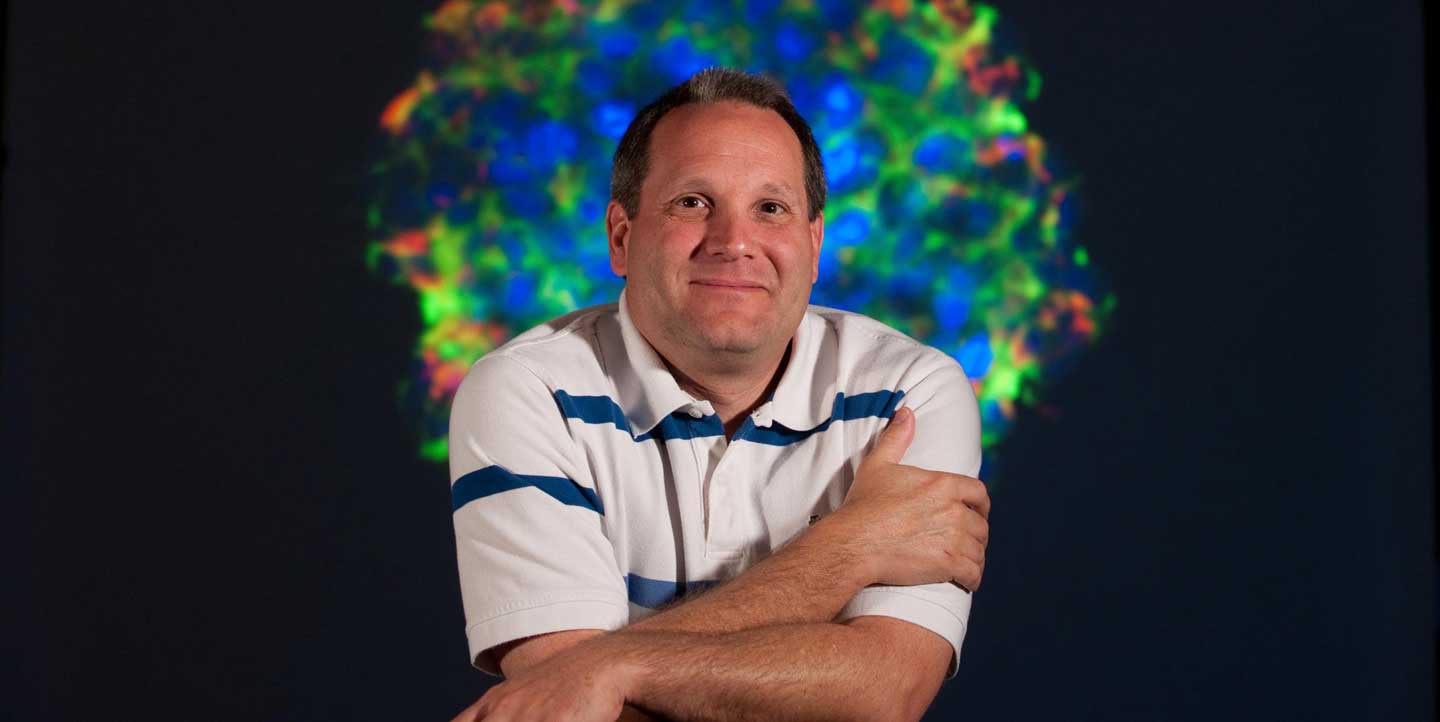
Brian Cummings
Credit: Daniel A. Anderson / UCI
Tackling concussions
UCI is a hotbed of cutting-edge brain research, including important studies on concussions. One of the school’s newest head-injury investigators is Dr. Massimo Fiandaca, an Italian-born associate professor of neurology and neurological surgery who once worked as a team physician for the Boston Red Sox and co-invented a blood test that predicts Alzheimer’s disease. In collaboration with UCI colleagues and scientists at Georgetown University and the University of Rochester, he has now devised a blood screening method that could revolutionize concussion diagnosis. Fiandaca’s group discovered a blood component – or biomarker – that changes in reaction to traumatic brain injury. UCI plans to conduct trials with its men’s water polo team this summer to determine how soon after impact the indicator shows up. Fiandaca also helped launch a concussion screening program last fall for all varsity athletes at UCI.
Elsewhere on campus, Brian Cummings, a professor of physical medicine & rehabilitation, is looking for ways to prevent concussion-related dementia in athletes. Using skin biopsy stem cells from Alzheimer's patients, he grows miniature "brains" in a three-dimensional bioreactor, then tests compounds designed to fend off neurodegeneration.
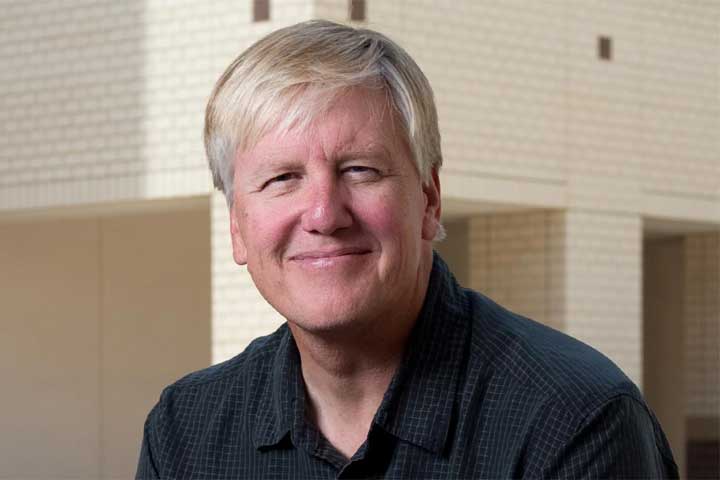
Douglas Granger
Credit: Steve Zylius / UCI
A mouthwatering look at exercise
As a spit science pioneer, Douglas Granger has collected saliva samples from sea lions, soldiers and would-be Mars astronauts. The UCI professor also helped design a "salivary bioscience laboratory" inside the Nebraska Cornhuskers' new football stadium, where researchers use "oral fluid" specimens to chart players' circadian rhythms so they can avoid overtraining. Granger's work on improving athletic performance has drawn inquiries from several NFL teams and other pro sports franchises. His Institute for Interdisciplinary Salivary Bioscience Research is housed at UCI.
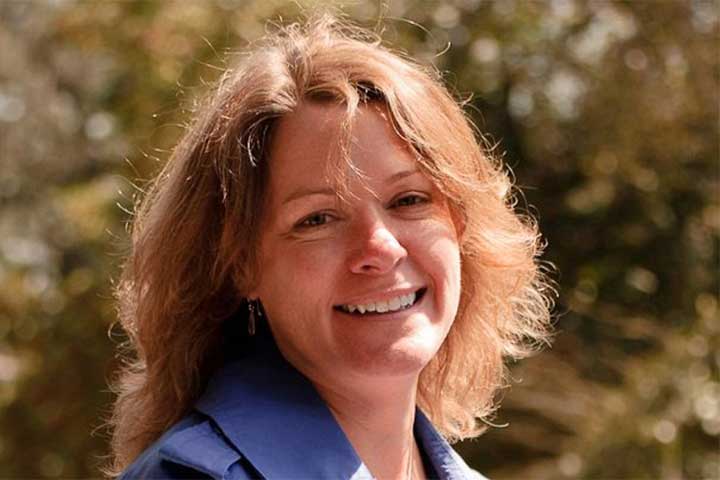
Victoria E. Johnson
Adding females to the fan equation
As the Rams continue efforts to rebuild their Southern California fan base, Victoria E. Johnson’s writings offer insights into the ways pro football has appealed to female followers. The UCI associate professor of film & media studies analyzes the marketing of “masculine” sports culture to a post-Title IX generation of women. Last year, for instance, she dissected the NFL's use of gender-targeted charity efforts the NFL’s use of gender-targeted charity efforts, ad campaigns and promotions to offset criticism of football’s domestic violence and concussion issues.
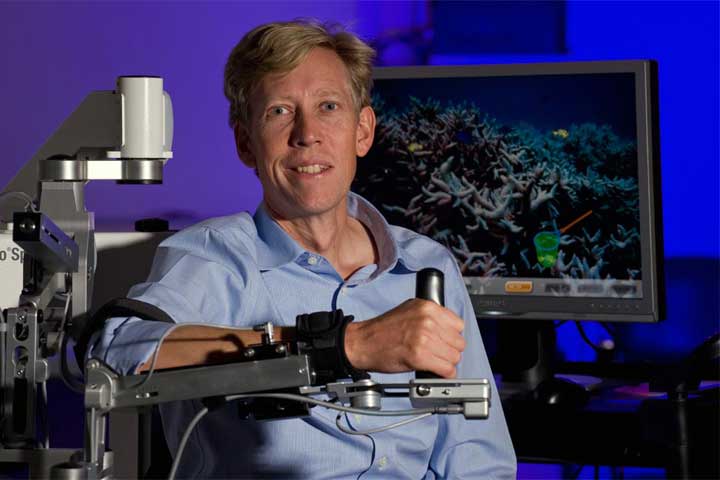
Professor David Reinkensmeyer demonstrates one of the rehabilitative devices in UCI's innovative iMove lab.
Credit: Steve Zylius / UCI
Robots, rappers and rehab
In a futuristic UCI lab called iMove, physical therapy patients don robotic arms, electronic gloves and other exoskeleton devices – including one that appeared in rapper Dr. Dre's "I Need a Doctor" video (at 5:54) – that could be adapted to help injured athletes. David Reinkensmeyer, a professor of mechanical & aerospace engineering, anatomy & neurobiology and biomedical engineering, says iMove is also developing wearable sensors to track wrist, arm and leg motion, which could be useful for optimizing sports performance.
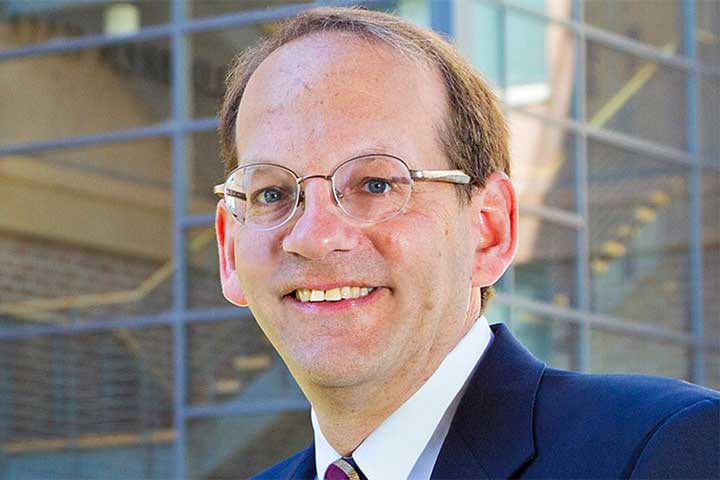
Hal Stern
Photo courtesy of the UCI Donald Bren School of Information & Computer Sciences
Beating the odds
When it comes to predicting final scores or the likelihood of an individual play succeeding, Hal Stern is the ivory tower equivalent of a Las Vegas oddsmaker. The Stanford- and MIT-trained sports geek, who taught at Harvard before launching UCI’s statistics department and later becoming dean of the Donald Bren School of Information & Computer Sciences, employs complex mathematical formulas to calculate the probability of winning a football game, among other efforts. Working from an office decorated with games of chance (such as 100-sided dice), Stern achieved a dose of fame a few years ago for his scholarly takedown of the Bowl Championship Series ranking system, which he called “a sham.”
The Physics of Football
UCI professor explains the science behind effective tackling and throwing
If Isaac Newton were alive today, he'd probably be a vampire, because how else do you explain someone living to the age of 373? He might also be entranced by pro football as a laboratory on the laws of physics, including some of his own discoveries.
For example, tackling and blocking demonstrate Newton's third law of motion, which states that for every action, there's an equal and opposite reaction.
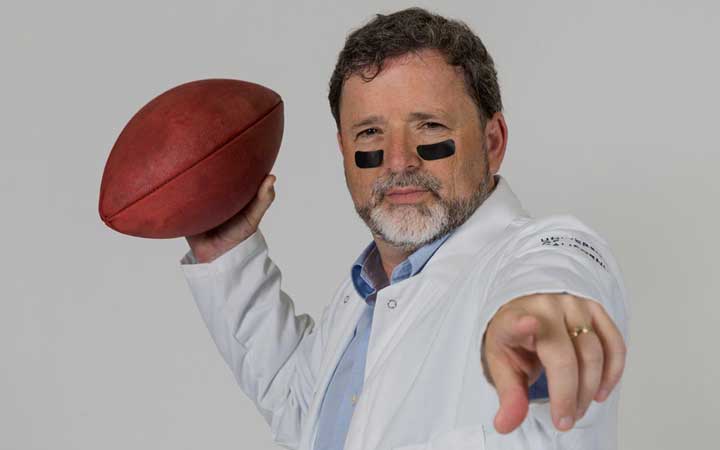
Physicist Michael Dennin, vice provost for teaching and learning at the University of California, Irvine
"When two players collide, both feel the same amount of force during the hit," says physicist Michael Dennin, vice provost for teaching and learning at the University of California, Irvine.
So why does one player usually come out ahead? "The only other relevant force is the ground," Dennin says. "The way you win is by using that surface. If you hit someone with an upward angle, it gives you a more effective net force because you're pushing off the turf."
That makes leg strength crucial for players, but the upper body is also important, he adds: "In tackling, you need arm and core muscle power to maintain a grip on your opponent."
One additional factor is the point of contact. Tackling is essentially about rotating the ball carrier down to the ground, Dennin says, so where you hit him determines success. "Think of trying to close a door," he says. "If you apply force close to the hinge, the door doesn't move much. But if you apply force at the handle, the door closes easily."
Another aspect of the game that showcases scientific principles is passing.
"The football is a fun physics object because it's not a sphere," Dennin says. "The secret to a stable pass is the spiral."
When thrown properly, a football rotates about 600 times a minute, or 12.5 mph, he says. "It's a good example of angular momentum," the same force at work in a gyroscope or spinning top, Dennin says. It keeps the ball on target. Without a good spiral, he notes, the football flies like "a wounded duck." And you don't have to be Isaac Newton to know that a wobbly pass is more likely to be intercepted.

Student Success
Last summer, the inaugural Rams camp at UCI also became the training ground for 10 students and alumni from our Department of Film & Media Studies, who worked as production assistants on HBO’s reality television show “Hard Knocks,” which followed the progress of the Rams while they were on campus. Here is their story.
Read Story: Training camp becomes training groundMascot Matchup
Peter vs. Rampage
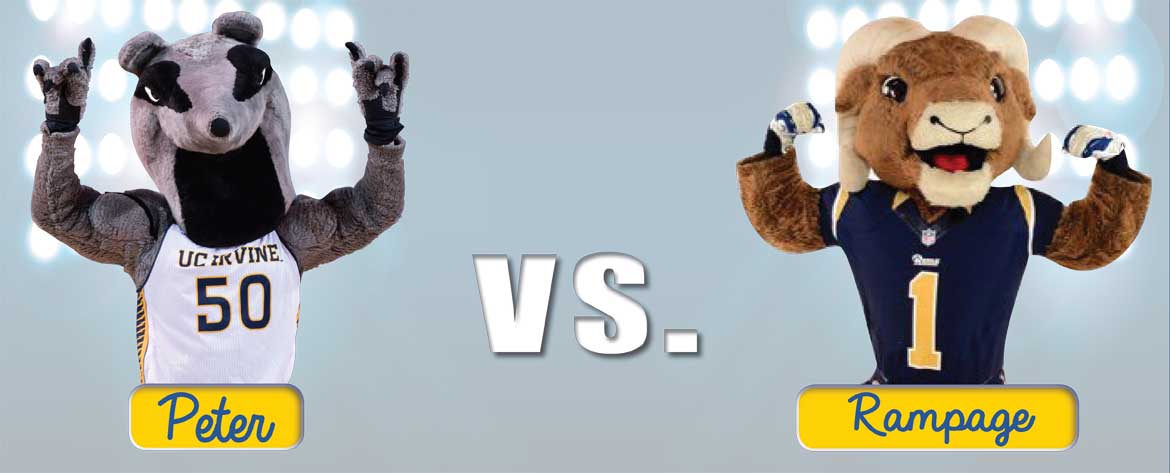
| Statistic | Peter | Rampage |
|---|---|---|
| Gender | Male | Male |
| Age | 51 | 11 |
| Hometown | Irvine | L.A. & St. Louis |
| Honors | Mashable's Mascot Madness Champ | Star on the Hollywood
Walk of Fame |
| Celeb Fans | Conan O'Brien | Nelly |
| Height | 6'9" | 6'1" |
| Education | College major: Sprit, Loyalty
Minor: Entertainment & Tradition |
MA in Turf
Management |
| Fav. Movie | Empire of the Ants, Antz, Ant-Man | Rambo |
| Weight | A gentle-ant never tells | 200 lbs |
| Fav. Hangout | Aldrich Park | L.A. Zoo |
| Food | Ants, duh! | Seahawk wings |
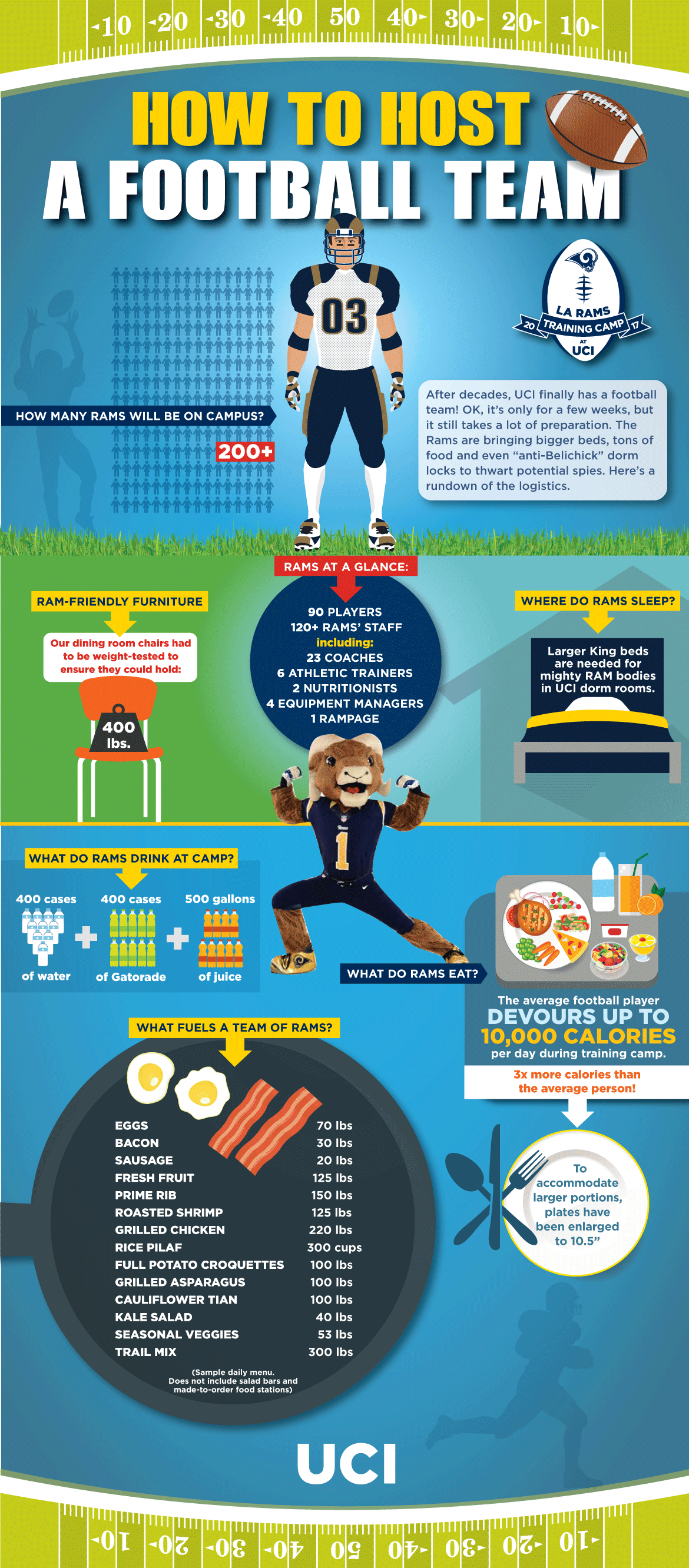

Social Media
Twitter#RamsAtUCI
Join us on social media and share your posts with #RamsAtUCI.
Follow Us! Facebook Instagram